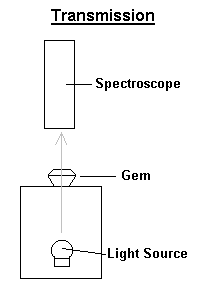The Optical Spectrum and the Spectroscope
The spectroscope is a device that separates white light into an optical spectrum of component colors that can aid in gemstone and mineral identification.
2 Minute Read
The optical spectrum of a gemstone may be extremely useful in identification or in distinguishing between two gemstones that look alike, which is why optical properties are often mentioned in gemstone articles.
The primary tool used to determine the optical properties of gemstones is the spectroscope. To understand how a spectroscope works, we must first examine the underlying principle of what light is. Light that we refer to as white light actually consists of a mixture of all the wavelengths in the visible range combined in specific proportions. When such light passes through a colorless material, none of the light is absorbed, which causes the white light to emerge unchanged. However, when light passes through a material designed to absorb various portions of the white light, only some wavelengths are allowed to emerge and reach our eyes. The portion that emerges consists of white light from which certain wavelengths have been subtracted, so we only see certain colors. For example, if the material absorbs red, orange, and most of the yellow wavelengths, only blue and green remain, which means the light emitted appears blue-green in color. This explains why gemstones appear certain colors. Take a ruby. It appears red to us because the gemstone absorbs nearly all of the violet and green light passing through it.
The optical spectroscope is a device that separates white light into a spectrum of component colors, using either a prism or a diffraction grating. The spectrum consists of either an infinite, in the case of a prism, or a finite, in the case of a diffraction grating, assemblage of images of a very narrow slit, each representing a different wavelength. A gemstone placed between the light source and the slit will absorb certain wavelengths. The slit images of these wavelengths are consequently missing from the observed spectrum and, therefore, show up as dark lines. The width of the lines depends on the diameter of the slit, which is usually adjustable. Often entire segments of the spectrum are absorbed, and the result is a dark band rather than a line. While some light sources used in spectroscopy produce all visible wavelengths, others may not produce all visible wavelengths. If a spectroscope is aimed at the sun, for example, the observed spectrum contains dark lines even though there is no absorbing material in front of the slit. These are known as Fraunhofer lines, named after Joseph von Fraunhofer (1787-1826) who showed them to represent absorptions by elements within the gaseous outer layers of the sun's atmosphere.
Certain gemstones have very distinctive spectra. In general, an optical spectrum is created through the agency of certain atoms in the crystal structure, which are, in the final analysis, responsible for the light absorption. Emerald, for example, contains chromium, so the spectrum of emerald contains very distinctive absorption lines representing chromium. These absorption bands are located in the far red portion of the spectrum. While it is usually not possible to identify a gemstone based solely on spectral data, this information is useful once you have narrowed your options down to a handful of gemstones that have distinctive optical characteristics. For example, you cannot distinguish between a ruby and a garnet simply by examining each with a spectroscope. Some gems, however, have extremely unique spectral information that can be used for identification purposes. These gems include apatite, zircon, olivine, sinhalite, and idocrase.
Joel E. Arem, Ph.D., FGA
Dr. Joel E. Arem has more than 60 years of experience in the world of gems and minerals. After obtaining his Ph.D. in Mineralogy from Harvard University, he has published numerous books that are still among the most widely used references and guidebooks on crystals, gems and minerals in the world.
Co-founder and President of numerous organizations, Dr. Arem has enjoyed a lifelong career in mineralogy and gemology. He has been a Smithsonian scientist and Curator, a consultant to many well-known companies and institutions, and a prolific author and speaker. Although his main activities have been as a gem cutter and dealer, his focus has always been education. joelarem.com
Related Articles
Learn to Use a Refractometer (Video)
Refractometer Guide, Part 2: Cabochon Testing
“Genesis And Classification Of Agates And Jaspers: A New Theory” Book Review
Polariscope Guide, Part 1: Testing Gemstone Refraction
Latest Articles
800 Years of Mogok: A Celebration in Tenuous Times
What is the Average Gemstone Faceting Yield?
Pyroxmangite Value, Price, and Jewelry Information
How to Identify Emerald Simulants and Synthetics
Never Stop Learning
When you join the IGS community, you get trusted diamond & gemstone information when you need it.
Get Gemology Insights
Get started with the International Gem Society’s free guide to gemstone identification. Join our weekly newsletter & get a free copy of the Gem ID Checklist!
